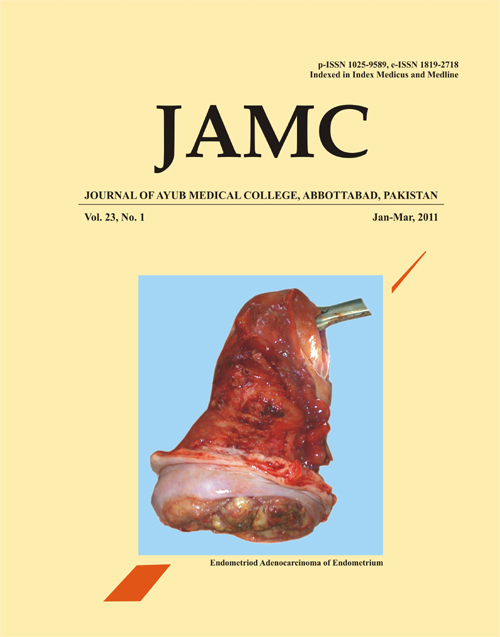PLATELET COUNT IN MALARIA PATIENTS
Abstract
Background: Malaria is a major health problem in the tropics with high morbidity and mortality.This study is conducted to analyse the effects of malaria on platelets. Methods: This prospective
study was conducted on 200 diagnosed cases of malaria in Department of Medicine, LUMHS,
Jamshoro/Hyderabad from February to December 2010. The diagnosis of malaria was carried out
by thin and thick blood films. Platelet count was performed using an automated counter.
Thrombocytopenia was classified as mild (50-150ï‚´103 cells/µl), moderate (20-50ï‚´103 cells/µl)
and severe (<20ï‚´103 cell/µl). Results: The age of patients ranged from 16 to 80 (28±10.5) years,
median age was 30 years. Among the study population, males were 124 (62%) and females were
76 (38%). Out of them 105 (52.5%) were cases of Plasmodium falciparum, 93 (46.5%) were of P.
vivax, and 2 (1%) were of P. malaria. The data showed that 171 (85.5%) patients were having low
platelet count; 141 (70.5%) had mild, 21 (10.5%) moderate, and 9 (4.5%) had severe
thrombocytopenia. Twenty-nine (14.5%) patients had normal platelet count. Conclusion: Malaria
is associated with different degrees of low platelet count with rarely increased bleeding tendency.
Keywords: Malaria, Falciparum, Platelets
References
Jadhav UM, Patkar VS, Kadam NN. Thrombocytopenia in
Malaria, Correlation with Type and Severity of Malaria. J Assoc
Physicians India 2004;52:615-8.
Wickramasinghe NS, Abdalla SH. Blood and bone marrow
changes in malaria. Clinical Haematology 2000;13,277-99.
McMorran BJ, Marshall VM, de Graaf C, Drysdale KE, Shabbar
M, Smyth GK, et al. Platelets kill intraerythrocytic malarial
parasites and mediate survival to infection. Science
;323:797-800.
Price R, Tjitra E, Guerra C, Yeung S, White N, Anstey N: Vivax
malaria: neglected and not benign. Am J Trop Med Hyg
;77:79-87
Price R, Douglas N, Anstey N: New developments in
Plasmodium vivax malaria: severe disease and the rise of
chloroquine resistance. Curr Opin Infect Dis 2009;22:430-5.
Yamikani C, Kondwani K, Terrie T, Malcolm M. The Platelet
Count in Cerebral Malaria, Is It Useful to the Clinician? Am J
Trop Med Hyg 2010;83:48-50.
Akhtar MN, Jamil S, Amjad SI, Butt AR, Farooq M. Association
of malaria with thrombocytopenia. Ann King Edward Med Coll
;11:536-7.
Memon AR, Afsar S. Thrombocytopenia in hospitalized malaria
patients. Pak J Med Sci 2006;22:141-3.
Hassan A, Ahmed A, Ahmed S, Abdulla M, Hassan MH, Rania
M. Thrombocytopenia in adults with acute malaria. Rawal Med J
;34,170-3.
Sheraz J, Fazal R, Muhammad U, Sameena Z. Malaria can lead
to Thrombocytopenia. Rawal Med J 2008;33:183-5.
Zubair W, Muhammad T, Faisal H, Muhammad A, Ghulam R,
Abdullah D. Thrombocytopenia and Benign Tertian Malaria.
Infect Dis J 2010;19:192-5.
Shuaib A, Haji K, Allauddin A, Israr A, Fatima Q.
Thrombocytopenia in plasmodium falciparum malaria. J Ayub
Med Coll Abbottabad 2009;21,145-7.
Taha K, El-Dein SZ, Idrees M, Makboul G, Baidas G.
Haematological changes in malaria in relation to Plasmodium
species. Kuwait Med J 2007;39:262-7.
Idro R, Ndiritu M, Ogutu B, Mithwani S, Maitland K,
Berkley J, et al. Burden, features, and outcome of
neurological involvement in acute falciparum malaria in
Kenyan children. JAMA 2007;297:2232-40.
Kalyan S, David J, Angela A, Munekazu Y, Craig N, Pieter H.
Platelet Factor 4 Regulation of Monocyte KLF4 in Experimental
Cerebral Malaria. PLoS ONE 2010;5:104-13.
José A. Malignant malaria and microangiopathies: merging
mechanisms. Blood 2010;115:1317-8.
Fernanda M, Bernardo S, Andréa T, Agnaldo L, Sálua C, Cor
J, Cristiana F, Luzia H. Augmented plasma microparticles
during acute Plasmodium vivax infection. Malaria Journal
,9:327-9.
Downloads
Published
How to Cite
Issue
Section
License
Journal of Ayub Medical College, Abbottabad is an OPEN ACCESS JOURNAL which means that all content is FREELY available without charge to all users whether registered with the journal or not. The work published by J Ayub Med Coll Abbottabad is licensed and distributed under the creative commons License CC BY ND Attribution-NoDerivs. Material printed in this journal is OPEN to access, and are FREE for use in academic and research work with proper citation. J Ayub Med Coll Abbottabad accepts only original material for publication with the understanding that except for abstracts, no part of the data has been published or will be submitted for publication elsewhere before appearing in J Ayub Med Coll Abbottabad. The Editorial Board of J Ayub Med Coll Abbottabad makes every effort to ensure the accuracy and authenticity of material printed in J Ayub Med Coll Abbottabad. However, conclusions and statements expressed are views of the authors and do not reflect the opinion/policy of J Ayub Med Coll Abbottabad or the Editorial Board.
USERS are allowed to read, download, copy, distribute, print, search, or link to the full texts of the articles, or use them for any other lawful purpose, without asking prior permission from the publisher or the author. This is in accordance with the BOAI definition of open access.
AUTHORS retain the rights of free downloading/unlimited e-print of full text and sharing/disseminating the article without any restriction, by any means including twitter, scholarly collaboration networks such as ResearchGate, Academia.eu, and social media sites such as Twitter, LinkedIn, Google Scholar and any other professional or academic networking site.










